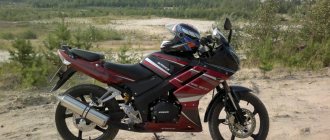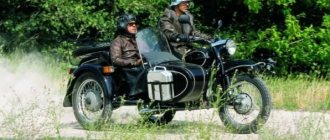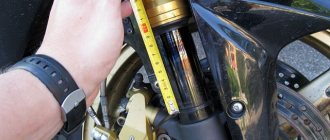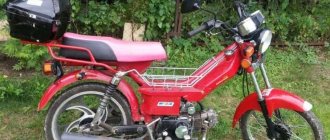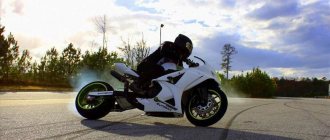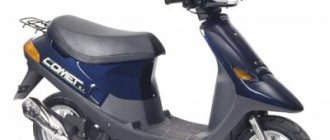Before adjusting the carburetor, wash the air filter. It is recommended to wash it after every 10 hours of operation. After this you can start making adjustments. The example photo shows the carburetor of the PRORAB-8406 petrol trimmer. The numbers indicate the adjusting screws that we will use.
Carburetor adjustment screws for petrol trimmer PRORAB-8406
Purpose of adjusting screws:
- Fuel mixture supply adjustment screw.
- Idle speed adjustment screw.
- Maximum speed limit screw.
Start the lawn mower and wait until it warms up.
Fuel supply adjustment
Start slowly turning the fuel mixture adjustment screw until the engine starts to stall, or until it stalls if you don’t have time to catch the moment. After this, unscrew the screw a quarter turn if the engine does not stall, or half a turn if it does stall. Start the stalled engine. Check by opening the throttle to see how the engine picks up speed. Continue unscrewing screw No. 1 a quarter turn until the engine, when accelerating, begins to confidently gain increased speed. This will be the moment of the most economical stable operation of the engine. For the petrol trimmer PRORAB-8406, the adjusting screws are turned clockwise and unscrewed counterclockwise; for some other brands of gas trimmers it may be the other way around.
Idle speed adjustment
Let's start adjusting low speeds. Screw No. 2 limits the return movement of the throttle lever - by turning it, we increase the idle speed, and by unscrewing it, we decrease it. Adjust so that the engine runs confidently at low speeds and even a little faster (for better starting), but so that the reel with fishing line or the knife does not rotate, and there is a sufficient reserve of revolutions before they begin to rotate. If the engine has difficulty starting, increase the idle speed further.
Maximum speed limit
After adjusting the fuel mixture supply and low speed, check how the lawnmower engine will operate at maximum speed. If necessary, limit the maximum speed to the required level using the #3 hollow screw. Loosen the locking nut and screw in the screw to decrease the maximum speed, or turn it out to increase. After adjustment, tighten the nut. Setting the maximum speed is necessary to protect the trimmer motor from overheating and the ability to use the start key lock to reduce fatigue of the right hand.
In the future, it may be necessary to adjust the trimmer carburetor. For example, if the engine starts to rev poorly when running at full load, unscrew screw No. 1 another quarter turn. If starting is difficult, increase the idle speed. Both weather conditions and the quality of the fuel mixture can affect the operation of lawn mowers. Vibration can cause the adjusting screws themselves to turn.
ATV shoots the muffler
The most common factor that can cause an ATV to shoot into the muffler and subsequently stall is low-quality or improperly prepared fuel. If the mixture is not sufficiently saturated with gasoline, then the motorbike owner will hear whole batches of distinct pops, the frequency of which will increase as the engine picks up more revolutions.
When the gasoline content in the fuel is too high, some of the fuel collects on the walls of the muffler, and after some time an explosion occurs. This process produces a loud bang and causes the ATV components to burn out.
You can determine the quality of the fuel in a motorcycle’s gas tank not only by how it fires, but also by the appearance of the spark plug. With a fuel mixture with a low gasoline content, it will have a pale tint, and if it is too rich, it will accumulate noticeable velvety soot.
Fortunately, fixing this problem is quite simple; you just need to adjust the carburetor needle valve, setting the optimal ratio of gasoline and oxygen.
The ATV may shoot into the muffler due to severe contamination of the fuel at the inlet. This may occur under the influence of the following factors:
- clogged motorbike fuel filters;
- deformation of the gasket responsible for sealing;
- failure of the pipe seal due to cracks or gaps.
Advantages and disadvantages of the Chinese small-capacity model
- + Affordable price - in this segment this is undoubtedly one of the main advantages.
- + Inexpensive consumables and spare parts, which are always available at Stels dealers.
- + Gasoline consumption is about 3 liters per 100 km, which, in combination with a 17-liter tank, gives the Stels Flame 200 motorcycle a huge power reserve. If you decide to go on a trip on this bike, you will appreciate this fact.
- + Effective brakes by budget class standards.
- + The most simplified and therefore reliable design.
- — Low maximum speed - about 120 km/h.
- — Weak traction at high speeds.
- — If there is a passenger or large cargo, the dynamics of the bike noticeably sags.
Chinese carburetor for 125-150cc engine - disadvantages and tuning.
What is the carburetor of a Chinese scooter and its capabilities, disadvantages, tuning.
The carburetor in a Chinese scooter with an engine capacity of 125-150 cm3 is installed from a line of constant vacuum carburetors. This type of carburetor is also installed in Chinese-made motorcycles, ATVs, and snowmobiles, but what makes it so popular? The answer is simple - smooth running, safety, efficiency, environmental friendliness. Even in a simplified and cheaper version, which is used in China, it is applicable for use in Europe under strict environmental and safety requirements. The lack of reliable information among users of Chinese-made motorcycle products has given rise to many myths and misconceptions - this is noticeable when contacting us for advice when tuning an engine and specifically a carburetor.
1.What does a typical, standard Chinese carburetor look like for a 4-stroke engine with a volume of 125 cubic centimeters or more. One of the options, because they may differ slightly.
This carburetor does not have a manufacturer's mark, model, or serial number - a complete unknown. Most often, such carburetors need to be carefully measured, because they leave a lot of room for hoaxes.
This version has some symbols that bring us closer to the clue to the origin of this carburetor.
There is a modified logo of the prototype from which this carburetor was copied - the Keihin brand. Above you can see the imprint of the Chinese manufacturer - the letters K F. Please do not be mistaken - this is not a type of carburetor, there will be information about it a little later. Then there is the imprint STANDARD OF JAPAN, which means absolutely nothing. This carburetor was not made in Japan, that's for sure. Whether it was made to the high standards of Japan is also highly doubtful. This inscription is designed only to make the user think that his carburetor is somehow Japanese - which is not true. The serial number is stamped on the carburetor, which is a positive factor - the manufacturer monitors the quality of the product to some extent, there is a link to at least something. But this is not a guarantee that the product is of high quality, but only one of the factors.
There is also such a “miracle” - an outright fake with an unsuccessful attempt to imitate the Keihin logo and inscription, but such products are generally beyond criticism for many reasons.
DESIGN OF JAPAN, TECHNOLOGY FROM JAPAN - there is no such inscription on any Japanese carburetor, remember this. The inscription “Japan, Made in Japan” may be cast on the carburetor, but not on a Chinese carburetor.
What is the name of this carburetor, this photograph alone gives an idea.
Carburetor model PD24J. The VE carburetor type is also visible, which is a residual from the original. Just don’t rush to open a search in the hope of finding a Keihin PD24J - such a model does not exist! PD24 is absolutely the “Chinese name” of the original Keihin VE24 carburetor, little information about which can be found on the Internet. Why is there little information about the original? It is outdated and of little use compared to the more modern Keihin CVK series.
This is what the original looks like, it was not easy to find a photo.
The identification of the Chinese carburetor and the Japanese prototype from which it was copied is completed - let's move on to considering the details.
What nuances are encountered with a typical Chinese carburetor?
1. Mismatch of diffuser sizes. The diagram shows a step in the carburetor diffuser that “steals” the size from 24 mm to 22 or even 20.
That is, the outgoing flow of the mixture from the carburetor moves in a diameter of 22 millimeters, and before entering the pipe it expands, creating unnecessary vacuum and even turbulence. Of course, these turbulences are minimal if the inlet and outlet of the pipe, the inlet hole in the cylinder head are of the same diameter - this segment often includes unpleasant surprises.
A couple of weeks ago I crossed the first 10,000 kilometer mark in my motorcycling life. And I did this thanks to my Stels Flame 200. There is only one picture, below are my impressions, descriptions and thoughts about this unit. Lots of books.
So, at the end of April I decided on the choice of my first motorcycle and purchased a Flamka. I chose the unit for daily trips around the city and trips to the dacha, 100-150 kilometers.
Mot showed himself to be just that. Light, nimble, feels great in the city, the only negative is the fairly wide steering wheel and the original mirrors, which hang exactly at the level of the mirrors of SUVs and crossovers, so beloved in our capital, which is already crowded with transport. The lightness of the motorcycle and the large angle of rotation of the steering wheel allows you to easily change from row to row in a traffic jam, even if the cars are pressed very tightly against each other. It feels almost like riding a bicycle. At the same time, the bike’s power is quite enough to keep up with fast traffic both on the Third Transport Ring and on the Moscow Ring Road. On the Moscow Ring Road, I left the left lane only if I was driving there in the dead of night, when the racers are leaving and the whole traffic is going much faster than the 120 km/h ceiling of the Flame. A small remark, I will talk about the real speed measured using GPS, my speedometer helpfully lies by about 10%, you are happy with the number 130, but there is no point... Although for some it is a joy. The flame is lightweight and has a nice modern design .
First impressions were good, the only thing I really wanted was sixth gear. The engine is a single-barrel engine, which means it has a lot of torque at medium speeds and an absolutely sluggish top end. I was ready for this. Maximum torque at 5.5 rpm, power at 7.5. Normal operating rpm is exactly 5-8 thousand, just have time to click the gears. The engine chirps and drives. I solved the issue of short gears at one and a half thousand mileage, changing the drive sprocket from the original 15 teeth to a 17-tooth one from a fairly well-known Soviet unit called “Ant”. It fits like a original, the only thing is that it needs to be secured with a lock washer, and not with two screws. But it's not a problem. By the way, the issue price is 75 rubles per star and 2 rubles per puck. As a result, I got a normal first gear, I no longer had to shift in the first second, and fifth became fifth, no more and no less. By the way, the engine has enough torque to not only maintain speed in fifth gear, but also accelerate or drive uphill. As a result: the engine is high-torque in the middle , the gearbox is too short
Native tires do not perform well . If possible, it should be replaced with something normal, but I will say that due to the lack of one, I still have my family, the rear tire has already acquired a noticeable shelf and, in general, after a couple of thousand it will show indicators of critical wear. The front one, surprisingly, has remained as it was, probably the reason for the not very good braking.
There are enough brakes. But I want more. In front there is one disc with a 4-piston caliper, in the rear there is a disc with a 2-piston caliper. On this bike, it is advisable to connect the rear brake to the front brake; in this case, the braking dynamics improve significantly, but it is still better to be careful; on the original tires, the rear wheel easily skids. I still curse at myself every time for over-braking with the rear. Perhaps this balance of power happens because of the tires. On the last batches of flames, the back one was different, softer with at least some kind of grip resulting from this. The original hoses are literally wadded. You press the handle, the force increases, the braking improves sluggishly, so I quickly replaced the front hose with a reinforced Venhil one. The handle became harder, the stroke decreased, now it slows down exactly as much as you press. But still it was not possible to make stoppie. Maybe it’s the tires again, maybe the suspension, or maybe just the geometry of the bike.
The suspension is moderately stiff . At the rear there are two shock absorbers with remote compensation tanks with pumping. For my weight of 67 kilos, it seems a little harsh, and it bounces the rear point especially unpleasantly at the junctions with the track, which we often encounter on the Third Transport Ring. But with the second number, even if it’s a guy, it’s quite possible to drive even on a broken road. The backside has never been pierced. The front fork seemed like the golden mean to me, but many people said that it would be nice to make it stiffer. It is known from forums and VK groups that this can be successfully solved by replacing the oil with a thicker one. Otherwise, it works pleasantly at full speed, absorbs bumps and doesn’t wobble. And, by the way, the front fork is upside down, it looks nice =)
The seat is hard , everyone complains about it, that in long-distance driving the fifth point becomes numb. Perhaps I ride in armored shorts, thanks to the rigid protection of the coccyx, and the load is distributed differently, so that 300 km at a time went as normal for me without the need to stop and stand.
The native light leaves much to be desired . Well, what can two 35W light bulbs do? Neither to illuminate the road nor to show oneself in the flow. I had to drive with the long-range one at first... Without hesitation, I installed the xenon. At first I used both headlights, but then I didn’t like that the high beam one took a long time to light up, it’s not fun at night outside the city. While you are waiting for it to flare up, it is time to extinguish it because of the oncoming car. As a result, I installed a full-fledged halogen in the distant one. By the way, both of our bulbs have an H4 base. But in the near one only the near thread works, in the far one only the far one, and in order not to overload the wiring, when you turn on the far one, the near one goes out. Not a problem, so after spending a couple of hours I solved this problem. I ran the normal wiring through the relay from the battery and made sure that when the high beam was on, it would also give a signal to the low beam. As a result, it is now quite comfortable to move around at night. The original headlight gives a clear horizontal light-shadow boundary on the low beam. The distant one shines with a narrow beam towards the horizon.
Until mileage 7500, I just changed the oil and filled up with gasoline, and had no problems. The first absurdity happened at this figure - the throttle cable broke, the lead barrel in the throttle handle came off. It was in Moscow, there was a tire service nearby, so an hour later I drove on my own towards home. Next came the replacement of the throttle cable, the price was 100 rubles. But while I was out buying a cable, I came across a fresh, larger carburetor and decided that this was a sign for tuning.
Initially, I knew that the engine was designed for poor Chinese fuel and lubricants, so it has a compression ratio of 8.3. In principle, with this figure you can pour 80 gasoline into it, but I drove on 92. I was thinking of increasing the compression ratio to 10, installing a carburetor with a larger diffuser , then it seemed to me that this was precisely what was stifling the movement at the top. So I bought a fresh PZ-30 carb with an accelerator pump to replace my PZ-27, a forked throttle cable, took the engine head to be milled and waited. When the head arrived, I did porting in the head, bored out the intake manifold from 25-27mm in narrow places to 30mm so that everything matches the carburetor, made smooth transitions without steps or corners. At the same time, I changed the chain, because... the original chain sucks ... 428 chain 128 links from the Kirov plant - 250 rubles. Over the 2500 km that I drove, I had to tighten it once, although sometimes my own one had to be tightened almost once every 300-500. The engine became faster, it didn’t turn better, but the maximum speed increased by 10 km/h, from 120 to 130. In terms of numbers, this turns out to be approximately a 15% increase in power.
The first serious breakdown was not long in coming and happened at 8500 km; my gearbox secondary shaft bearing, which is near the drive sprocket, fell apart. There is a possibility that at first I overtightened the chain and that killed him, but still he shouldn’t die like that. Conclusion - defective. Because I had already gotten into the engine and didn’t have to pay RUB 2,000 to the officials for an oil change; I didn’t have to count on a warranty. Without thinking twice, I removed the engine and took it home to tinker with it in the evenings. I cut it in half, took out the hero of the occasion, looked at everything else and decided that what the hell, out of harm’s way, I’ll change all the other bearings too. No sooner said than done, I spent 750 rubles, I had a set of shaft bearings in my hands, and within a day I was already starting.
Then everything returned to its place, the bike drives, I’m happy.
Well, my story wasn’t entirely rosy, it was overshadowed by a breakdown, and quite a serious one at that, but as I understand it, no one else had such breakdowns. To judge the reliability, you still need statistics, which either don’t exist yet or they speak in favor of the flame.
In general, having driven these ten thousand, I understand that this is a very good option for moving around a city like the capital, where the traffic is dense, there are a lot of traffic jams, but when there are no traffic jams, they go quite quickly. I also understand that this is an option for a person who is not afraid of possible breakdowns and the need to modify some things for himself, because in fact, those who are now riding these Chinese cars are pioneers, we are studying his childhood illnesses and similar things, but Mostly we just ride and enjoy. A motorcycle for the city, for people without racing ambitions. It eats about 3.5 liters per hundred in the “all money” mode. He can easily take him to his dacha in the evening without traffic jams to get some fresh air for two to three hours longer.
Well, I think that the most important thing is that even despite that breakdown, I don’t want to get rid of it, so I continue to enjoy the rest of our short season and will probably open the next one also on Flame, but that’s how it goes. Now I already want the opportunity to drive on the highway 140-150, when the road allows, and I fell in love with the sound of the V-twin.
Design characteristics of Stealth Flame 200
In fact, the motorcycle does not have any hints of a sports model. This is an ordinary classic that will make many nostalgic for Soviet bikes. The high-tech style can be seen in every detail.
The muffler favorably emphasizes the high cost of the vehicle. On the Stealth Flame 200, even the rear shock absorber spring, which was painted red, gives a unique uniqueness to the image. In the photo of the stealth flame 200 you can see that the headlight resembles the Yamaha Tenere, which adds style to the design.
Comfortable fit will not leave anyone indifferent. The wide steering wheel improves handling and maneuverability.
Replacing a carburetor on a Ural motorcycle
Before starting the installation, you need to prepare, adapt the mounting locations for the mixer on the cylinder, the cables on the right steering wheel console, and the air filter pipe.
- The distance between the centers of the holes on the PZ30 carburetor flange is less than the center-to-center spacing of the studs on the cylinder. It is required to make (purchase) adapters - eccentrics. Externally, the adapter screw looks like three successively joined parts:
- thread to suit the size of the stud, the length is determined by the depth of the cylinder bore;
- area without thread to suit the thickness of the sealing gasket;
- threaded part with an offset center, with a diameter suitable for a flange eye.
- Modify the adjusting bushings on the cables and the holes in the handle.
Go through the remote control with a 7 mm drill and cut an M8 thread.
The bushing is made in the form of a cylindrical part. It is screwed into the remote control using an M10 threaded connection. The cable housing has an M8 thread. In the middle there is a washer with a notch.
The modification is as follows:
- M10 change to M8;
- grind off the notch for four to six edges for ease of holding with a wrench.
The work can be done in two ways
A safe, professional way . Remove the upper end stops of the cables and process them on a machine in a vice. The process is lengthy, the quality of the cutting is guaranteed, and the possibility of damaging the cable and hands is eliminated.
A method for extreme sportsmen . Sharpen with an angle grinder by eye. The uniformity of processing leaves much to be desired. There is a risk of injury and damage to the product.
- Instead of a rubber pipe, it is possible to stock up with zero air filters that are attached directly to the carburetor.
- Product assembly.
- Set the eccentrics to the appropriate distance and secure the carburetor.
- Secure the cables on three sides (steering wheel, accelerator, accelerator pump). Achieve synchronous control of two mixers by changing the stroke length of the cables.
- Connect the air filtration system.
- Start the engine and adjust the speed.
Setting up a pit bike carburetor
Having determined the quality of our mixture, we begin to turn the carburetor. In reality, it looks something like this: first we try to achieve the desired mixture by raising or lowering the needle one or two notches, we try to ride it, if the difference is felt immediately, we continue to conjure until the desired result is achieved. Don't forget about the suction. The carburetor must be adjusted with the engine warm and the choke closed . If the difference is not immediately visible, we ride longer, then evaluate the results of the adjustment by the color of the spark plug. If you can’t adjust the needle, then return the locking ring on the needle to the middle position (default) and select the jets. The carburetor must be supplied with a set of jets of different sizes. The nozzle has two sizes: the first is the thread diameter (m5, m6, etc.), the second is the throughput of the nozzle in cm3/min (the numbers are stamped on the nozzle itself). You can change the jet or check its size by removing the carburetor from the pit bike, draining all the gasoline from it and opening the float chamber by unscrewing two bolts. The jet looks like a flathead screwdriver bolt with a through hole in the middle.
Alpha a and power
Carburetors of motorcycles IZH Jupiter-5, 4, 3
Most motorcyclists know that for the combustion of gasoline in the engine cylinder, a certain amount of air is needed. And that the mixture of this air with gasoline is formed in the carburetor and can be “normal”, “rich”, “poor”. At the same time, the technology of our days is very reliable, and there are almost no conflicts between the motorcyclist and the carburetor. Many people ride serenely, completely forgetting about the presence of such a “cunning” thing on a motorcycle. But some are unlucky. The vagaries of the carburetor force them to delve into theory. They have already learned that the combustion of 1 kg of gasoline theoretically requires about 15 kg of air and that in reality the combustible mixture entering the engine cylinders may, as luck would have it, fall far short of this ideal case. Either there is too little air, then suddenly there is too much! How long? Let's try to answer this and a number of other questions that should interest everyone, especially young motorcyclists.
First of all, let's get acquainted with the excess air coefficient a (“alpha”). This is the ratio of the amount of air actually entering the cylinder to that theoretically required for complete combustion of the fuel. A mixture for which this coefficient is equal to one is called normal. If it is less, then the mixture is rich, and if it is more, then it is poor. But here’s the problem: it turns out that not every mixture of gasoline and air ignites from a spark! There are limits. They correspond to the lowest and highest alpha values at which the mixture is still capable of igniting. For gasoline at an initial temperature of 0 degrees Celsius, these values of the excess air coefficient are 0.53 and 1.23, respectively. The composition of the mixture on which the engine operates during operation lies somewhere within these limits, having a strong impact on its power, efficiency, and temperature conditions.
Young people, as you know, love fast driving and therefore strive, first of all, to “extract” the most power from the engine. It is achieved using enriched mixtures, with an excess air coefficient of 0.8-0.9. Having achieved what he wanted - speed, such a motorcyclist receives in addition a bunch of, at first glance, invisible, but in fact very, very noticeable troubles. Incomplete combustion of the mixture, poor efficiency, accelerated deposits of carbon on engine parts and in the exhaust system, as well as a toxic gray-blue cloud behind, saturated with carbon monoxide, sulfur compounds, nitrogen oxide, etc.
Meanwhile, if you adjust the carburetor to obtain a lean mixture (a = 1.1 -1.15), then combustion will become more complete, efficiency will be better, and the doses of poison emitted into the atmosphere will also be reduced. True, the engine power will decrease somewhat, but a road motorcycle is used most of the time with partial loads, and they require from the engine only a portion of the power that it is capable of developing. Therefore, it is worth giving preference to a lean mixture at increased alpha values. It is clear that to obtain the same power with an excess air coefficient of 1.15, you will have to give more “gas” than with a = 0.8. But in practice, drivers feel this difference only when they need to quickly increase speed (lean mixture, reducing power, also affects acceleration dynamics).
So, if we proceed from the fact that for a road motorcycle, efficiency and engine safety are of decisive importance, then at partial loads it is advisable to lean the mixture. But we will talk about this in more detail later. And now briefly about the design of the carburetor.


